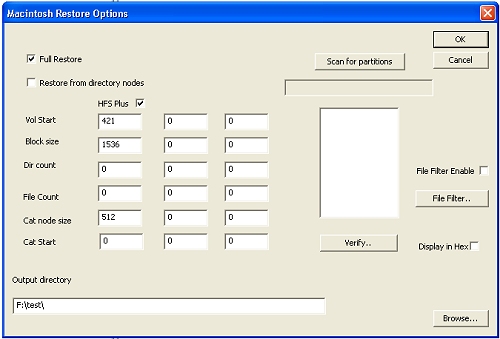|
Macintosh Drive Data Recovery
|   |
Macintoshes use a file system call HFS and HFS+. CnW Recovery, although it is a PC program has several tools and modes of operation to help recover files from disks that have become corrupted, or suffered partial failure.
When a Mac disk is selected for recovery, the following option screen is displayed - data is obtained from the volume header

The screen allows for three partitions to be recovered, and the basic entries for each partition are displayed and may be edited. The entries are as below
Vol Start
This is the first sector of a logical volume. For an HFS+ volume, logical sector 2 always starts H+. Sector 2 is the volume description block. There are occasions when the H+ sector is missing, or corrupted. In these cases the alternate backup copy is examined and used if appropriate
Block size
This is the logical block size that is used to allocate data, ie the amount used to write a 1 byte file. It is always a multiple of 512 bytes. For HFS disks, there can only be 64K such blocks on a disk.
Dir Count
This is the number of directory entries stored on the partition
File count
This is the number of files started on the partition
Cat node size
The catalog on a Mac disk is basically a file with fixed length records, or nodes. The size of the node is critical in recovering the disk. Typical sizes for 80GB disks are 4096 or 8192 bytes (0x1000 or 0x2000). It is normally similar in size to the Block size, and will always be a multiple of 512 bytes
Cat Start
The cat start is the starting location of the catalog file
Recovery modes
There are three basic recovery modes that can be use.
Full Logical Recover will read the disk in a similar way to the operating system, but is very tolerant of any errors.
Recover from directory scan. This will read the catalog file and try and recover each entry in a leaf node. This mode will trap any file on a disk that has a broken directory tree. It is a very useful mode to use when there are failed sectors in the directory area of the disk. It is common on a damaged disk for files to be saved into 'dummy' directories with names such as dir_9865.
Recover from directory nodes will scan the complete disk for possible catalog entries. This mode would be used when there is considerable damage in the catalog area of the disk. The scan can be slow as it will examine the complete disk. However, it does not rely on a valid catalog tree extents information
Scan for Partitions
The scan for partitions function will scan the complete disk and try and determine if there are any possible starts to partitions. Any such starts are displayed in the box under the Scan for Partitions button. If the entry is double clicked, it will be placed into the column for the first partition, and the other parameters will be updated.
Scan for catalogs
The scan for catalogs will scan the complete disk and isolate the probable starts for a catalog. If the value is clicked, the entries in the first partition (the first column) will be initialised so that data from the selected catalog can be read.
Verify...
Processing Resource forks
On Apple disks, HFS+, files often contain both data and resource forks. There is also an important part of Metadata stored in the directory that indicates the application that should open the file. PCs tend to work just on file extensions, but Macs have a 'hidden parameter to assist, and so the file name is not actually important. On OS X, there is a method of sharing this information on a standard PC disk. The method is called AppleDouble format. Put simply, for every file there is an associated file with the same name, but prefixed ._. For example for fred.doc there will also be a file ._fred.doc This extra file will be at least 82 bytes long, and longer if there is an associated resource fork. By using these files, the Mac on OS X can treat a FAT disk in the same way it handles a native HFS+ disk, and no information is lost.
OS9 uses a different method - not yet implemented in CnW software.
The type of output required on a disk is chosen by the flag OS X on the options screen
A Macintosh will not read an NTFS disk, so if data is to be transferred to a MAC, a FAT32 must be used. Many external USB drives come as NTFS, and Windows will not reformat a drive as FAT32. It is therefore necessary to use an external program to format a drive as FAT32. One such program that has been tried is fat32format.exe that can be downloaded free of charge from the web. Writing to an external FAT32 drive is very slow unless the write cache is enabled. On grounds of performance, make sure the output drive properties are set for performance and not quick removal.
Shortcuts and Hypertext links
Many times when copying files recovered by CnW to a Macintosh, the Macintosh cancels with an error message of 'The operation cannot be completed because you do not have sufficent priviledges for some of the items'. This has been found to be due to programs missing, or hypertext links missing. It has been found on both a network copy, or when the Mac is reading a FAT or NTFS disk locally. It is often found when the Macintosh being used to copy, is not the original system machine. To overcome this, CnW examines the resource fork and removes and 'slnk' or 'hlnk' on the resource fork. Files now copy without stopping. It does mean that some links will no longer work, but it will ensure that all data is copied.